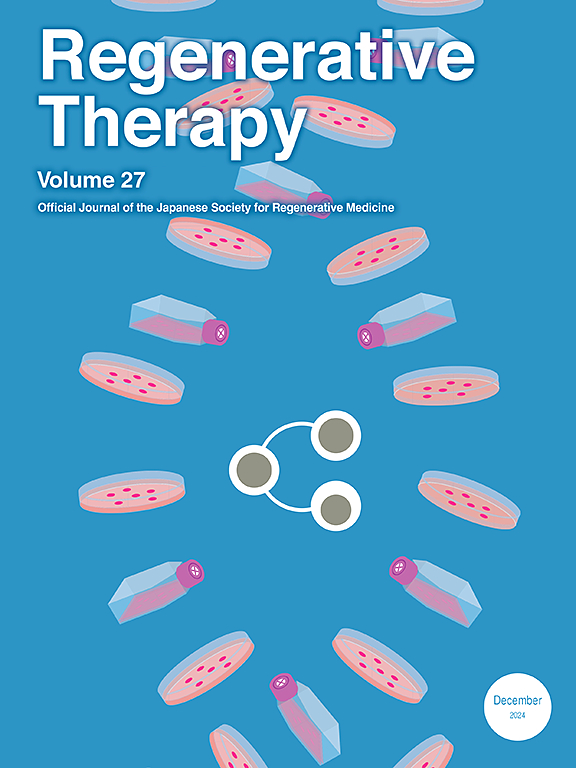No simple way to averaging out: Pooled mesenchymal stromal cells do not reflect average donor characteristics
IF 3.5
3区 环境科学与生态学
Q3 CELL & TISSUE ENGINEERING
引用次数: 0
Abstract
Background
Mesenchymal stromal cells (MSCs) are promising candidates for numerous regenerative therapies. Still, clinical translation is complicated by the heterogeneity of MSCs and related shortcomings in preclinical research. Pooling MSCs from multiple donors is increasingly being advocated as an effective way to mitigate donor variability. However, it remains unclear whether the range of individual cell characteristics is equally reflected in pooled cultures, or if pooling rather leads to a homogenized cell population dominated by the fittest donor, which would lead to skewed results. This study investigates whether MSC pools are functionally representative for their respective donor MSCs and whether dominant donors emerge over time.
Methods
MSCs from nine human donors were categorized into low-, middle-, and high-fitness groups. Individual MSCs were then pooled according to their fitness groups, complemented by a mixed-fitness pool. Functional assays for proliferation, metabolic activity, differentiation, migration and senescence were performed to evaluate the pools versus the individual MSCs. Donor representation within pools was tracked using fluorescence microscopy and qPCR.
Results
The high-fitness pool, as well as its individual donor MSCs, displayed the most rapid proliferation and highest metabolic activity. However, while for proliferation, the pool data aligned well with the individual donor data, all other assays revealed discrepancies between the pooled cultures and individual donor cells. Interestingly, particularly the mixed fitness pool showed inferior metabolic activity and differentiation potential in comparison with the respective individual donor MSCs. Cell tracking showed that over one passage, even pools composed of donors with similar cell fitness became dominated by the donor with the highest cellular fitness.
Conclusions
The discrepancy between pooled and individual donor data emphasizes the importance of biological replicates to capture donor variation and ensure that MSC research reflects natural diversity.
没有简单的平均方法:汇集的间充质间质细胞不能反映供体的平均特征
间充质基质细胞(MSCs)是许多再生治疗的有希望的候选者。然而,由于间充质干细胞的异质性和临床前研究的相关缺陷,临床翻译变得复杂。越来越多的人提倡将来自多个供体的间充质干细胞集中起来,作为减少供体多样性的有效方法。然而,目前尚不清楚单个细胞特征的范围是否在混合培养中得到了同样的反映,或者混合培养是否导致了由最适合的供体主导的均匀细胞群,这将导致结果偏差。这项研究调查了MSC池是否在功能上代表了各自的供体MSC,以及是否随着时间的推移出现了主导供体。方法将9例人类供体的smscs分为低、中、高适应度组。然后根据其健身组对单个msc进行汇总,并辅以混合健身池。进行增殖、代谢活性、分化、迁移和衰老的功能分析,以评估池与单个MSCs的差异。使用荧光显微镜和qPCR追踪供体在池中的代表性。结果高适能池及其供体间充质干细胞增殖最快,代谢活性最高。然而,尽管对于增殖,池数据与个体供体数据很好地一致,但所有其他检测显示池培养和个体供体细胞之间存在差异。有趣的是,特别是混合健身池与各自的单个供体间充质干细胞相比,显示出较差的代谢活性和分化潜力。细胞追踪显示,经过一次传代,即使是由细胞适应度相似的供体组成的供体池也会被细胞适应度最高的供体所支配。结论集合供体和个体供体数据之间的差异强调了生物复制对捕获供体变异和确保MSC研究反映自然多样性的重要性。
本文章由计算机程序翻译,如有差异,请以英文原文为准。
求助全文
约1分钟内获得全文
求助全文
来源期刊

Regenerative Therapy
Engineering-Biomedical Engineering
CiteScore
6.00
自引率
2.30%
发文量
106
审稿时长
49 days
期刊介绍:
Regenerative Therapy is the official peer-reviewed online journal of the Japanese Society for Regenerative Medicine.
Regenerative Therapy is a multidisciplinary journal that publishes original articles and reviews of basic research, clinical translation, industrial development, and regulatory issues focusing on stem cell biology, tissue engineering, and regenerative medicine.
 求助内容:
求助内容: 应助结果提醒方式:
应助结果提醒方式:


